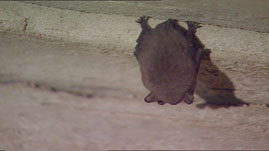Indiana bats hibernate in the winter months in large colonies. Ten percent of the entire population of endangered Indiana bats hibernate in Bat Cave, part of the Carter Cave system in Olive Hill, Kentucky. Its limestone walls and ceilings are among the few caves suitable for the Indiana bat during its winter hibernation months, usually October to early April. Bat Cave, considered a wild cave because it has no permanent lighting or manmade walkways, has a steady cool temperature, between 39-46oF, which allows the bats to reduce their body temperature and metabolic rate. This in turns allows them to conserve fat reserves throughout hibernation.
In the spring, Indiana bats emerge from their winter caves and migrate to their summer homes, which range across the eastern and the southern United States. The female Indiana bat stores sperm during hibernation and during spring becomes pregnant. Later, in the summer, female bats form maternity colonies of up to 100 individuals. When the “pup” is born in late June to early July, it is fed milk by the mother. After about a month it begins to fly out to catch insects. Eventually, as summer progresses, it will begin to store the fat reserves needed for the next winter.
These little quarter-ounce gray to brown furry mammals play an important role in the food web of the eastern United States. On a summer night, a bat colony may eat thousands of insects ranging from beetles to mosquitoes. Each bat will consume close to its body weight in insects per night. An average Indiana bat lives five to ten years, which means the importance of Indiana bats to insect control is substantial.
Its niche is important to the ecosystem, but populations of Indiana bats have declined. This decline is due to natural events, such as flooding, and to changes in the environment caused by human activity. Because the Indiana bats feed on insects, the use of pesticides, which affects insect populations, can reduce the availability of adequate food. Loss of access to caves and other natural habitats, caused by clear cutting of trees or land development, has reduced the maternity and summer feeding areas. Currently, Kentucky loses 130 acres a day to development and nationally the number may be as high as 6,000 acres a day. Also, if the bats' winter habitat is disturbed during hibernation, the bat colony can wake up and spend valuable energy trying to escape intruders. Bats need this stored energy to make it through the winter, so if their hibernation is disrupted they may die of starvation.
The preservation of Bat Cave, such as maintaining carefully controlled access to people, is an important step in helping these two inched, pink-nosed bats to survive.
